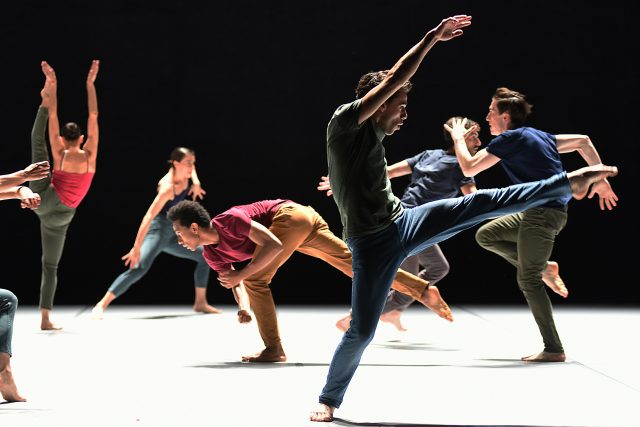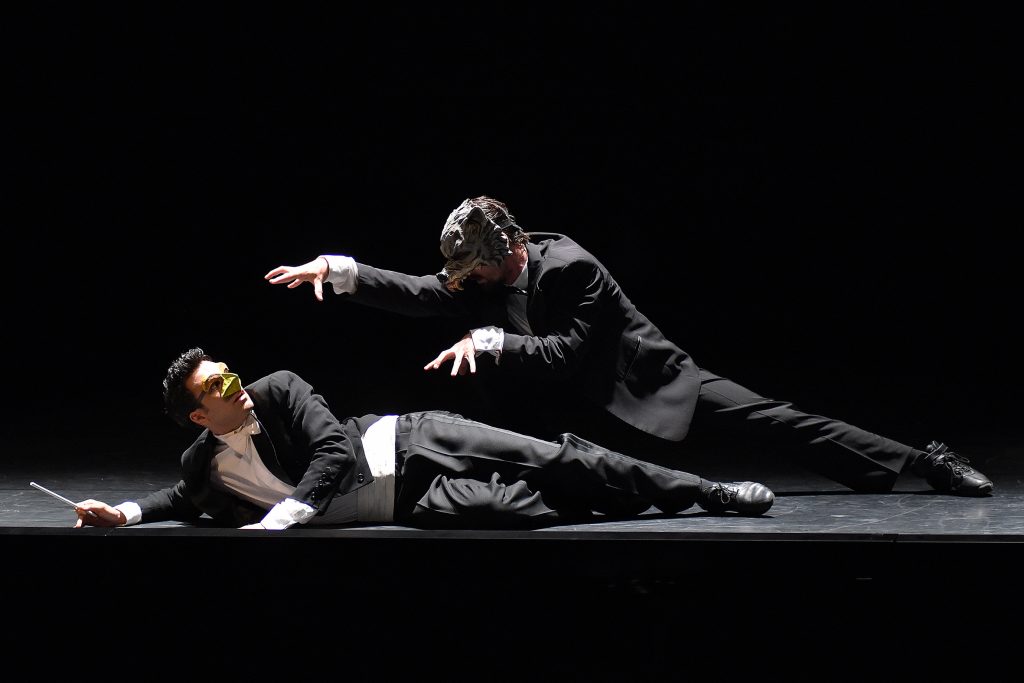
scroll down for the english version
BERLINO – Dal 15 al 19 gennaio 2020, presso l’Haus der Berliner Festspiele, dopo il grande successo di Nijinski e di Mega Israel, torna la Gauthier Dance con Classy Classics, un omaggio a cinque grandi ‘classici’ della danza contemporanea.
Come accade prima di ogni spettacolo è Eric Gauthier a salire sul palco per salutare il pubblico e presentare il programma della serata. Tra parole cariche d’ammirazione per i Maestri i cui lavori sono parte dello show e qualche sketch ironico che fa sorridere la platea, il direttore annuncia che ad aprire la serata sarà Decadance di Ohad Naharin, in una versione appositamente rivista per la compagnia di Stoccarda, a seguire Orchestra of Wolves dello stesso Gauthier, Herman Schmerman Duet di William Forsythe, Äffi di Marco Goecke e per finire Malasangre di Cayetano Soto.
Il primo pezzo ad andare in scena è Decadance di Ohad Naharin. I danzatori sono disposti in un triangolo di altezza crescente, si parte da chi è seduto al vertice fino a chi è in piedi nell’ultima fila. Alternando momenti di intensi e tecnici movimenti di braccia, mani e testa a brevi pause, i danzatori danno vita a un momento di forte impatto visivo per poi esplodere in una coreografia colorata e brillante, piena di immagini divertenti e virtuosismi eseguiti con ‘disinvoltura’ e leggerezza. Assolutamente riconoscibile lo stile di Mr Gaga, che con gli adattamenti proposti di città in città, continua a rendere un classico del suo repertorio sempre ‘fresco’ e attuale.
Dopo la pausa, la compagnia torna in scena con Orchestra of Wolves (2009), uno dei pezzi per cui è stato assegnato il German Dance Prize a Eric Gauthier. Sul palco ci sono un danzatore che interpreta un direttore d’orchestra con becco d’uccello e coda piumata, e otto musicisti, tre donne e cinque uomini, che indossano maschere da lupo. Quando il direttore dà il segno, l’orchestra comincia a suonare il primo movimento della quinta di Beethoven. Inizialmente, i lupi seguono la conduzione del direttore, ma poi iniziano a disobbedire ai suoi comandi: corrono da un lato all’altro del palco e giocano sulle sedie girevoli. La loro aggressività si intensifica quando un lupo perde al tipico gioco musicale delle sedie, per culminare in un agguato al pennuto direttore e al conseguente ‘banchetto’ in mezzo a una nuvola di piume gialle.
Subito dopo, Bruna Andrade e Nicolas Losada si cimentano nella difficile interpretazione di Herman Schmerman Duet (1992) di William Forsythe. L’elegante e iconico duetto, era stato creato per la straordinaria Sylvie Guillem. Da ciò si comprende perché, nonostante la bellezza del pezzo, il duetto sia stato presentato molto raramente sui palcoscenici di tutto il mondo. I giovani protagonisti si dimostrano all’altezza del compito ed eseguono lo straordinario duetto prima con sofisticata raffinatezza e poi, quando entrambi indossano le svolazzanti gonne gialle disegnate da Versace, con fine umorismo.
Forte, intenso, emozionante, coinvolgente è Äffi (2005) di Marco Goecke. Un difficile solo – bravissimo Theophilus Vesely – accompagnato dalle canzoni di Johnny Cash. Sembra quasi di spiare un uomo nella sua intimità, di vedere i suoi pensieri prendere forma, di sentire il suo dolore e provare le sue stesse emozioni… Circa 15 minuti di pura danza e musica che lasciano gli spettatori col fiato sospeso dall’inizio alla fine.
Ultimo pezzo ad andare in scena è Malasangre, coreografia appositamente creata per la Gauthier Dance da Cayetano Soto nel 2013. Il pezzo, in onore alla cantante cubana La Lupe, dovrebbe rappresentare i momenti di cattivo umore (letteralmente: ’sangue cattivo’), ma la musica, i colori e l’energia dei versatili danzatori della compagnia, trasmettono tutta l’energia che consentì alla famosa cantante di superare i dolori della sua vita.
Fantastica serata di grande danza in cui la Gauthier Dance conferma la propria consistenza e versatilità attraversando generi e stili diversi con sicurezza e tanto talento. La lunghissima ed entusiastica standing ovation dimostra l’apprezzamento dell’esigente pubblico della Haus der Berliner Festspiele.

From the 15th to the 19th of January 2020, at the Haus der Berliner Festspiele, after the great success of Nijinski and Mega Israel, Gauthier Dance returns with Classy Classics, a tribute to five great ‘classics’ of contemporary dance.
As usual, before each show, Eric Gauthier goes on the stage to greet the audience and present the evening’s program. Between words full of admiration for the Maestri, whose works are part of the show and some ironic sketches that make the audience smile, the director announces that Decadance by Ohad Naharin, as a specially revised version for the company from Stuttgart, will open the evening followed by Gauthier’s Orchestra of Wolves, Herman Schmerman Duet by William Forsythe, Äffi by Marco Goecke and at last Malasangre by Cayetano Soto.
The first piece to be performed is Decadance by Israeli choreographer Ohad Naharin. The dancers are arranged in the form of a triangle that increased in height with the dancer in the front row – at the summit of the triangle – kneeling down low and the dancers in the back row towering above. By alternating moments of intense and technical movements of arms, hands and head with short breaks, the dancers create a moment of strong visual impact and then explode into a colourful and brilliant choreography, full of fun images and virtuosity performed with ‘ease’ and lightness. Mr Gaga’s style is absolutely recognisable. With the proposed adaptations made for every city, Naharin continues to make this classic piece of his repertoire ‘fresh’ and more contemporary.
After the break, the company perform Orchestra of Wolves (2009), one of the pieces which earned Eric Gauthier the German Dance Prize. On stage there is a dancer who plays a conductor with a bird’s beak and a feathered tail, and eight musicians – three women and five men – who wear wolf masks. When the conductor gives the sign, the orchestra begins to play the first movement of Beethoven’s 5th Symphony. Initially, the wolves follow the director’s instructions, but then they begin to disobey his orders: they run from one side of the stage to the other and play on swivel chairs. Their aggression intensifies when a wolf loses at the traditional game of musical chairs, which then culminates in an ambush of the feathery director and the consequent ‘banquet’ in the middle of a cloud of yellow feathers.
Soon after, Bruna Andrade and Nicolas Losada attempt the difficult interpretation of Herman Schmerman Duet (1992) by William Forsythe. The elegant and iconic duet was created for the extraordinary Sylvie Guillem. This is why, despite the beauty of the piece, the duet was rarely presented very in the theatres around the world. The young protagonists prove themselves up to the task and perform the extraordinary duet first with sophisticated refinement and then – whilst both wearing the fluttering yellow skirts designed by Versace, – with excellent humor.
To follow is Äffi (2005) by Marco Goecke: a strong, intense, exciting and engaging piece. A difficult solo – performed by the very talented Theophilus Vesely – accompanied by music by Johnny Cash. It almost seems like spying on a man’s intimacy; to see his thoughts materialising, to feel his pain and to feel his own emotions… Äffi is 15 minutes of pure dance and music that leave the spectators in suspense from start to finish.
The last piece to go on stage is Malasangre, a choreography specially created for the Gauthier Dance by Cayetano Soto in 2013. The piece, in honour of the Cuban singer La Lupe, is supposed to represent the moments of a bad mood (literally: ‘bad blood’), but the music, the colours and the energy of the company’s versatile dancers convey all the energy that allowed the famous singer to overcome the pain she suffered during her life.
A fantastic evening of great dance in which the Gauthier Dance affirms its consistency and versatility by crossing different genres and styles with confidence and lots of talent. The long and enthusiastic standing ovation demonstrated the appreciation of the demanding audience at the Haus der Berliner Festspiele.














































